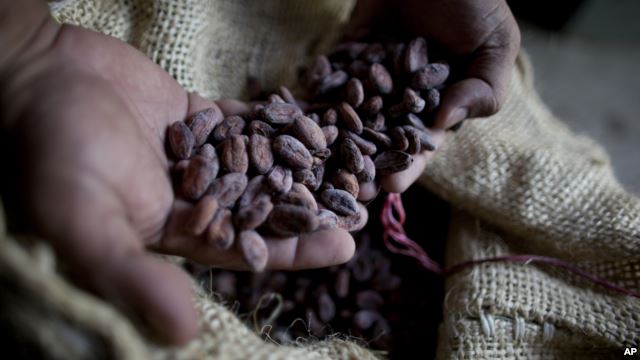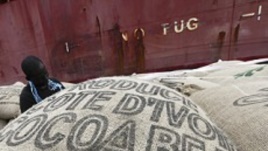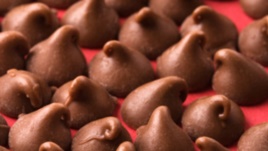VOA慢速英语:巧克力:食物中的上帝
From VOA Learning English, this is Science in the News.
I’m Anna Matteo.
And I’m Christopher Cruise.
Today on the program, we explore the history ofchocolate -- a favorite food for many people.Researchers have known for some time that chocolateis good for the heart. We will report on a study thatshows why this is so. We also tell you about the healtheffects of dark chocolate.
The Tasty History of Chocolate
The history of chocolate begins with a plant whosescientific name -- Theobroma cacao -- means “food of the gods.” For centuries, people have been enjoying therich flavor of chocolate, a product made from this plant.
Historians believe the Mayan people of Central Americafirst learned to farm cacao plants around 2,000 yearsago. The Maya took the cacao trees from therainforests and grew them around their homes. Theycooked the cacao seeds, then crushed them into a soft paste. They mixed thepaste with water and flavorful spices to make an unsweetened chocolatedrink.
Cacao and chocolate were an important part of Maya culture. There are oftenimages of cacao plants on Maya buildings and art objects. Ruling familiesdrank chocolate at ceremonies. And, even poorer members of Mayan societycould enjoy the drink once in a while. Historians believe that cacao seedswere also used in marriage ceremonies as a sign of the union between ahusband and wife.
The Aztec culture in current-day Mexico also prized chocolate. But the cacaoplant could not grow in the area where the Aztecs lived. So they traded to getcacao. They even used cacao seeds as a form of money to pay taxes or giveas offerings to the gods.
Only the very wealthy people in Aztec societies could afford to drink chocolatebecause cacao was so valuable. The Aztec ruler Montezuma was believed tohave drunk 50 cups of chocolate every day.
Some experts believe the word for chocolate came from the Aztec word“xocolatl,” which means “bitter water” in the Nahuatl language. Others believethe word “chocolate” was created by combining Mayan and Nahuatl words.
 |
|
In this photo taken Nov. 15, 2012, a worker shows a handful of dried cacao seeds at a cacao plantation in Cano Rico, Venezuela. |
The explorer Christopher Columbus brought cacao seeds to Spain after histrip to Central America in 1502. But it was the Spanish explorer HernandoCortes who understood that chocolate could be a valuable investment. In 1519, Cortes arrived in Mexico. He believed the chocolate drink would becomepopular with Spaniards. After the Spanish soldiers defeated the Aztec empire,they were able to seize the supplies of cacao and send them home. Spainlater began planting cacao in its colonies in the Americas in order to supplythe large demand for chocolate.
The wealthy people of Spain first enjoyed a sweetened version of thechocolate drink. Later, the popularity of the drink spread throughout Europe. The English, Dutch and French began to plant cacao trees in their owncolonies. Until the 18th century, only wealthy people could afford to drinkchocolate. During the period known as the Industrial Revolution, newtechnologies helped make chocolate less costly to produce.
Farmers grow cacao trees in many countries in Africa, Central and SouthAmerica. The trees grow in the shady areas of rainforests near the Earth’sEquator. But these trees can be difficult to grow.
They require an exact amount of water, warmth, soil and protection. Afterabout five years, cacao trees start producing large fruits called "pods," whichgrow near the trunk of the tree. The seeds inside this pod are harvested tomake chocolate.
Growing cacao is very hard work for farmers. They selltheir harvest on a futures market. This means thateconomic conditions beyond their control can affect theamount of money they will earn.
Today, chocolate industry officials, activists, andscientists are working with farmers. They are trying tomake sure that cacao can be grown in a way that is fairto the farmers and safe for the environment.
To become chocolate, cacao seeds go through a long production process in afactory. Workers must sort, clean and cook the seeds. Then they break off thecovering of the seeds so that only the inside fruit -- or nibs -- remain. Workerscrush the nibs into a soft substance called chocolate liquor. This getsseparated into cacao solids and a fat called cocoa butter.
 |
Chocolate makers have their own special recipes in which they combinechocolate liquor with exact amounts of sugar, milk and cocoa fat. They finelycrush this “crumb” mixture so it is smooth. The mixture then goes through twomore processes before it is shaped into a mold form.
Chocolate making is a big business. Each year, the market value of the cacaocrop around the world is more than five billion dollars. Chocolate is especiallypopular in Europe and the United States. Americans eat an average of morethan five kilograms of chocolate per person every year. Specialty shops thatsell costly chocolates are also very popular. Many offer chocolate lovers thechance to taste chocolates grown in different areas of the world.
Dark Chocolate and Heart Health
Researchers have known that chocolate -- especially dark chocolate -- isgood for the heart. Now, they know why. Besides tasting good, researchershave found that dark chocolate protects against heart disease in two ways: itreturns movement to hardening arteries. It also keeps white blood cells fromgathering on blood vessel walls. Both of these conditions can lead to plaqueformation. Plaque can block the flow of blood, causing heart disease.
Researchers from the Netherlands reported the findings. The Dutchresearchers studied 44 middle-aged men who were considered overweight. The men ate 70 grams of both dark and milk chocolate every day over twoperiods of four weeks.
The heart-healthy substance in chocolate is an organicsubstance called flavanol. Flavanols are also found invegetables, fruits and green tea.
Gerald Weissmann is with the FASEB Journal, whichpublished the study findings earlier this year. He saysthe researchers found that there is something about theflavanols in dark chocolate that makes people like itmore than milk chocolate.
“In this controlled study -- the first time it’s ever been done -- they gave thesame amount of flavanol in dark chocolate and regular chocolate. And lo andbehold, the men didn’t have different amounts of flavanols in the diet. But theyate more of the dark chocolate one because they liked it better.”
Mr. Weissman says researchers asked the men in the study to talk about thesmell and taste of dark chocolate.
 |
“So, the taste component or psychological component of dark chocolateimproved, number one, the elasticity and response of the arteries to bloodflow, number two, the way that neutrophils -- white cells -- stick to the lining ofblood vessels and number three, markers of inflammation.”
And knowing it was good for the heart seemed to make the men feel lessguilty about eating it.
Researchers may someday develop a treatment that has the same healthbenefits as dark chocolate. But even if they do, we are sure that eating a pieceof dark chocolate will still be more fun.
Scientists to Study Health Benefits of Chocolate
Dark chocolate has been shown to help prevent heart disease. But eating toomuch of it may cause people to gain weight. Now, scientists are looking for away to put dark chocolate’s helpful ingredients -- or parts -- into pills. Thatway, we can get the benefits of dark chocolate, but not the weight gain.
▶0:00:00⇱
- 频道推荐
- |
- 全站推荐
- 推荐下载
- 网站推荐




















